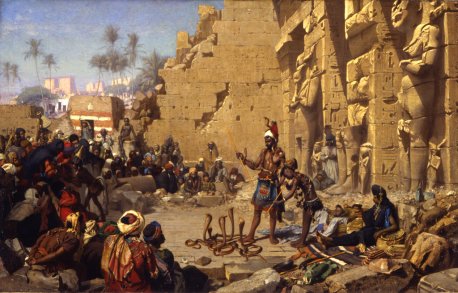The Snake Charmer
Egyptosophy
The Snake Charmer [ edit ]
The German Orientalist painter Karl Wilhelm Gentz here juxtaposes the mysterious aura of ancient Egyptian monuments with the magic of the “East.” Gentz trained in Berlin at the Academy of Fine Arts; he traveled to Egypt several times and painted multiple canvases based on his exploration of the ancient splendor and contemporary landscape of the Nile Valley. In The Snake Charmer, the sun-drenched outdoor setting of the dangerous performance is the forecourt of a New Kingdom temple. Gentz has used the north wall of the first court of the temple of Ramesses III at Medinet Habu temple as the template for the square columns decorated with engaged colossal statues that frame the right side of the scene. The cartouches of Ramesses III are clearly visible in the vertical columns of hieroglyphic text between the colossi, and the iconographic details of the royal images—including the uraei-fringed kilt and smaller statue—accurately capture the Medinet Habu colossi; the damage to the statues in Gentz’s paintings precisely corresponds to the westernmost three colossi of Ramesses III’s temple.
The damaged wall behind the colossi in The Snake Charmer has vertical columns of text copied from the western face of the second pylon of Medinet Habu, which is located immediately to the west of the colossi within the actual temple (Epigraphic Survey, Medinet Habu I, pls. 45-46); the hieroglyphic text is part of a lengthy historical inscription describing a campaign against the piratical Mediterranean groups known as the “Sea Peoples” who attempted to invade Egypt during the eighth regnal year of Ramesses III. Gentz has copied the hieroglyphs so accurately in The Snake Charmer that one can read the text from his painting; however, at the temple of Ramesses III at Medinet Habu, the pylon is entirely preserved, unlike the damaged wall in The Snake Charmer. Gentz appears to have used sketches of the Ramesseum for the architectural setting of his painting, but incorporated iconographic details and hieroglyphic texts from Medinet Habu.
Date
1872
Dimensions
23 1/2 x 36 1/2 in
Artist or Author
Karl Wilhelm Gentz
Provenance
Germany
Museum
Dahesh Museum
Accession Number
1995.54
M. Haja and G. Wimmer, Les orientalistes des écoles allemande et autrichienne (Paris, 2000), pp. 66-74.
L. Small, A Distant Muse, Orientalist Works from the Dahesh Museum of Art (New York, 2000), p. 35.








